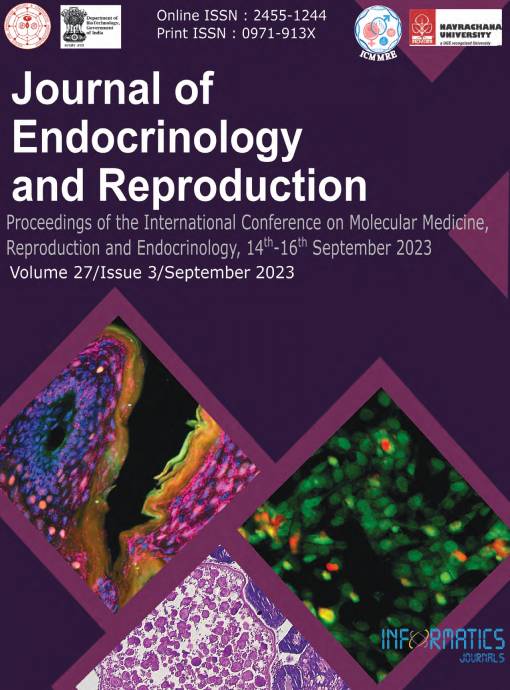Elucidating the Impact of Secretome Derived from Mesenchymal Stem Cell and Uterine Epithelial Cells During In Vitro Blastocyst Production in Buffalo
DOI:
https://doi.org/10.18311/jer/2023/34992Keywords:
Buffalo Embryos, Blastocysts, Mesenchymal Stem Cell, Secretome, Uterine Epithelial CellsAbstract
One challenge that needs to be addressed in animal embryo production is to create the appropriate in vitro culture to improve the blastocyst rate and produce high-quality embryos. Buffalo Mesenchymal Stem Cells (MSCs) were derived from Wharton’s jelly and expanded in vitro. Conditioned media (secretome) was collected from well-characterized WJMSCs at 3rd passage. Similarly, buffalo Uterine Epithelial Cells (UECs) were derived from nongravid uteri and expanded in vitro. The secretome was collected from a well-characterized first passage UECs monolayer primed with steroid hormones (progesterone 3.14ng/ml and estradiol-17β 5 31pg/ml). Culture media was replaced with non-serum media, and the media was collected after 72h. Day 4 IVF-derived embryos were cultured in three groups: in regular mSOF media (Group I), mSOF replaced with 50% CM derived from MSCs (Group II), and mSOF replaced with 50% CM from steroid-treated UECs (Group III). Blastocyst rates were evaluated on day 09 post IVF. The blastocyst rate in group II was significantly higher (p < 0.05) than the control group, which was further enhanced in group III. In vitro co-culture of embryos with the secretome derived from mesenchymal stem cells or steroid-treated UECs improved the blastocyst rate. UECs and their secretions are essential to establish uterine receptivity and to mimic the internal in vivo environment.
Downloads
Metrics
Downloads
Published
How to Cite
Issue
Section
References
Madan ML. Animal biotechnology: applications and economic implications in developing countries. Rev Sci Tech. 2005; 24(1):127-39. https://doi.org/10.20506/rst.24.1.1555. DOI: https://doi.org/10.20506/rst.24.1.1555
Pandey S, Bhat IA, Bharti MK, et al. Progesterone modulates adhesion molecules in uterine epithelial cells and in vitro embryo production in buffalo. Reproduction in Domestic Animals. 2020; 55:833–43. https://doi.org/10.1111/rda.13691. DOI: https://doi.org/10.1111/rda.13691
Wolf E, Arnold GJ, Bauersachs S, et al. Embryo-maternal communication in bovine - strategies for deciphering a complex cross-talk. Reproduction in Domestic Animals. 2003; 38:276-89. https://doi.org/10.1046/j.14390531.2003.00435.x. DOI: https://doi.org/10.1046/j.1439-0531.2003.00435.x
Hackett AJ, Durnford R, Mapletoft RJ, et al. Location and status of embryos in the genital tract of superovulated cows 4 to 6 days after insemination. Theriogenology. 1993; 40:1147–53. https://doi.org/10.1016/0093691X(93)90285-D. DOI: https://doi.org/10.1016/0093-691X(93)90285-D
Lonergan P, Gutierrez-Adan A, Rizos D, et al. Relative messenger RNA abundance in bovine oocytes collected in vitro or in vivo before and 20hr after the preovulatory luteinizing hormone surge. Molecular Reproduction and Development. 2003; 66:297–305. https://doi.org/10.1002/mrd.10357. DOI: https://doi.org/10.1002/mrd.10357
Richter KS. The importance of growth factors for preimplantation embryo development and in vitro culture, Current Opinion in Obstetrics and Gynecology. 2008; 20(3):292304. https://doi.org/10.1097/GCO.0b013e3282fe743b. DOI: https://doi.org/10.1097/GCO.0b013e3282fe743b
Gupta S, Pandey S, Parmar MS, et al. Impact of oocytesecreted factors on its developmental competence in buffalo. Zygote. 2017; 25(3):313-20. https://doi.org/10.1017/S0967199417000156. DOI: https://doi.org/10.1017/S0967199417000156
Ansari MM, Sreekumar TR, Chandra V, et al. Therapeutic potential of canine bone marrow-derived mesenchymal stem cells and its conditioned media in diabetic rat wound healing. Journal of Stem Cell Research and Therapy. 2013; 3:141. https://doi.org/10.4172/21577633.1000141. DOI: https://doi.org/10.4172/2157-7633.1000141
Joseph A, Indu B, Bhat IA, et al. Mesenchymal Stem CellConditioned Media: A Novel Alternative of Stem Cell Therapy for Quality Wound Healing. Journal of Cellular Physiology. 2020; 235:5555-69. https://doi.org/10.1002/jcp.29486. DOI: https://doi.org/10.1002/jcp.29486
Bhardwaj R, Ansari MM, Parmar MS, et al. Stem cell conditioned media contains important growth factors and improves in vitro buffalo embryo production. Animal Biotechnology. 2016; 27(2):118-25. https://doi.org/10.1 080/10495398.2015.1118383. DOI: https://doi.org/10.1080/10495398.2015.1118383
Loganathasamy K, Sharma GT. Does nitric oxide modulate in vitro maturation of caprine oocytes? Indian Journal of Animal Sciences. 2006; 76(2):114-7.
Pandey S, Somal A, Parmar MS, et al. Effect of roscovitine on developmental competence of small follicle derived buffalo oocytes. Indian Journal of Medical Research. 2018; 148(Supplement):140-50. DOI: 10.4103/ijmr.IJMR_2068_17.
Bevers MM, Dieleman SJ, Vandeb Hurk R. Regulation and modulation of oocyte maturation in the bovine. Theriogenology. 1997; 47(1):13-22. https://doi.org/10.1016/S0093-691X(96)00335-4. DOI: https://doi.org/10.1016/S0093-691X(96)00335-4
Rizos D, Ward F, Duffy P, et al. Consequences of bovine oocyte maturation, fertilization or early embryo development in vitro versus in vivo: implication for blastocyst yield and blastocyst quality. Molecular Reproduction and Development. 2002; 61(2):234-48. https://doi.org/10.1002/mrd.1153. DOI: https://doi.org/10.1002/mrd.1153
Yuan YQ, Van Soom A, Coopman FOJ, et al. Influence of oxygen tension on apoptosis and hatching in bovine embryos cultured in vitro. Theriogenology. 2003; 59:1585–96. https://doi.org/10.1016/S0093691X(02)01204-9. DOI: https://doi.org/10.1016/S0093-691X(02)01204-9
Simon C, Martin JC, Pellicer A. Paracrine regulators of implantation. Baillicre’s Best Practice and Research in Clinical Obstetrics and Gynecology. 2000; 14:815-26. https://doi.org/10.1053/beog.2000.0121. DOI: https://doi.org/10.1053/beog.2000.0121
Neira JA, Tainturier D, Penab MA, et al. Effect of the association of IGF-I, IGF-II, bFGF, TGF-β1, GM-CSF, and LIF on the development of bovine embryos produced in vitro. Theriogenology. 2010; 73(5):595–604. https://doi.org/10.1016/j.theriogenology.2009.10.015. DOI: https://doi.org/10.1016/j.theriogenology.2009.10.015
Forde N, Carter F, Fair T, et al. Progesterone-regulated changes in endometrial gene expression contribute to advanced conceptus development in cattle. Biology of Reproduction. 2009; 81(4):784-94. https://doi.org/10.1095/biolreprod.108.074336. DOI: https://doi.org/10.1095/biolreprod.108.074336
Mesquita FS, Ramos RS, Pugliesi G, et al. The receptive endometrial transcriptomic signature indicates an earlier shift from proliferation to metabolism at early diestrus in the cow. Biology of Reproduction. 2015; 93(2):52-61. https://doi.org/10.1095/biolreprod.115.129031. DOI: https://doi.org/10.1095/biolreprod.115.129031
Lakshmi Devi H, Shital Nagargoje D, Pandey S, et al. Embryo-uterine cross-talk: exploration of immunomodulatory mechanism in buffalo. Animals. 2022; 12(22):3138. https://doi.org/10.3390/ani12223138 DOI: https://doi.org/10.3390/ani12223138
 Vikash Chandra
Vikash Chandra






